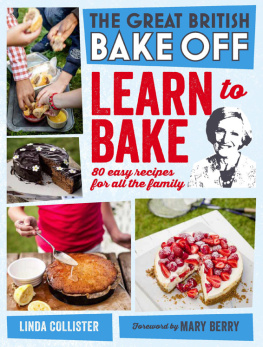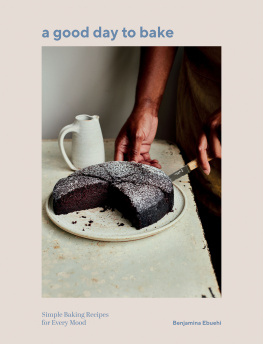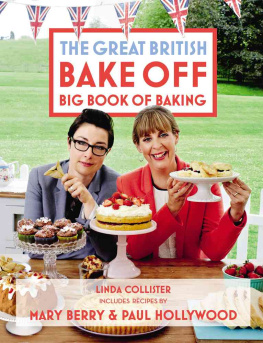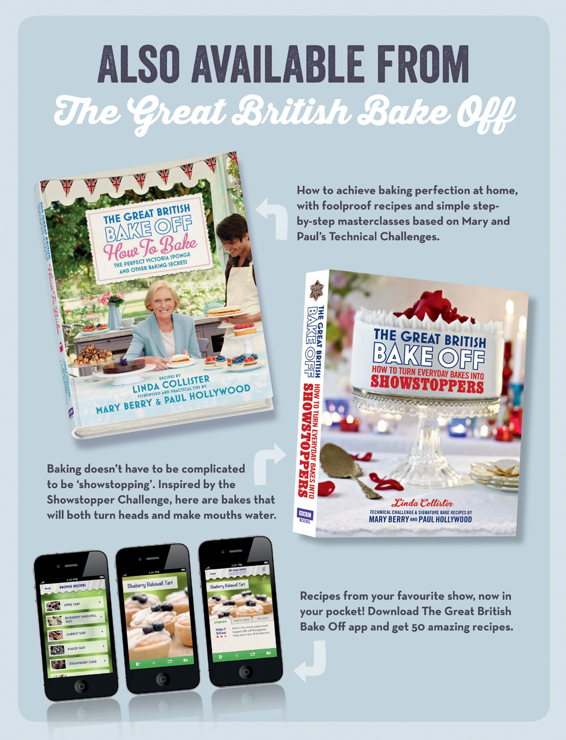A BIT OF HEALTH AND SAFETY
Two things cannot be more important when cooking keeping everything clean and keeping yourself safe from cuts, burns and scalds. Always check with an adult before you start baking talk about what you intend to do and how youll do it and ask for help when using sharp knives, electrical equipment and hot ovens and hobs.
Before you start, give your hands a really good scrub with plenty of soap (and use a nailbrush for any deeply dirty nails).
Tie back long hair so it cant get in the way, remove dangly jewellery (ditto), pull up long sleeves. You might want to wear an apron to protect your clothes because baking can get messy.
Give the work surface a good wipe down with a clean damp cloth so it is spotlessly clean. Make sure you do the washing up with hot soapy water (rinsing off the suds) but use cold water when youre making flour doughs for the initial clean-up or youll have a gluey mess.
Chopping boards need a good scrub after use (or run through the dishwasher). Take particular care if youre using meat, chicken or fish dont use the same equipment again until it (and your hands) have been properly cleaned.
Oven gloves are essential do not bake without them. Always put oven gloves on when you are using the oven and stand back when you open the door so you avoid the first rush of very hot air escaping.
Never, ever use damp oven gloves or cloths to lift tins and trays in or out of the oven.
ABOUT THE AUTHOR
LINDA COLLISTER knows a lot about baking she is the author of The Great British Book of Baking, The Great British Bake Off: How to Bake and The Great British Bake Off: How to Turn Everyday Bakes into Showstoppers. In Learn to Bake, Linda takes all of the skills used in The Great British Bake Off and breaks them down for beginners.
LOVE PRODUCTIONS is the television production company that devised and makes the BAFTA award-winning The Great British Bake Off and Junior Bake Off.
ABOUT THE BOOK
Love eating cake? Well, this weekend, get into the kitchen and make one yourself.
Baking is fun when you know how to do it, and you dont need lots of equipment or expensive ingredients.
Learn to Bake explains baking terms (how do you beat, fold or cream?) and special ingredients (what is strong bread flour?). Then it tells you everything you need to know to bake for every occasion and every person in your life.
Have a go at the recipes in this book with your friends and family get everyone involved, make a mess, have some fun and bake something to be proud of.
Acknowledgements
BBC Books and Love Productions would like to thank everyone involved who worked incredibly hard to make this book possible. We would particularly like to thank all the models that kindly volunteered their time for this book: Amber, Amy, Ben, Dabaye, Ella Bo, Fleur, Frankie, Freya, Grace, Harriet, Isabella, Kai, Lily, Luis, Maisy, Olivia, Oscar, Pedro, Ryan, Thomas, Urvashi, Victoria and William.
BAKING TERMS EXPLAINED
BAKING BLIND
This strange term really means baking empty. Its where you pre-bake pastry cases before adding the filling, so you end up with crisp pastry rather than a soggy bottom. Once youve rolled out the pastry, press it onto the base and sides of the tin ( for how to do this) then prick the base all over with a fork so it doesnt bubble up in the heat of the oven. The empty pastry case needs to be thoroughly chilled first allow 20 minutes to give it a chance to firm up so the fat or butter then melts evenly in the heat of the oven as the water turns to steam, keeping the starch grains in the flour separate.
Then, to prevent the sides of the empty pastry case from flopping in and the base from ballooning up, line the pastry with baking paper and weigh the paper down with ceramic or dried baking beans (ceramic or dried). for pictures of how to do this. Once the pastry has set, remove the paper and beans and then put the pastry case (still in the tin) back into the oven so the pastry can dry out, crisp up and brown a bit.
The pastry case can be filled once its cooled, then baked to cook the filling, if necessary.
BEATING
This means using a wooden spoon (or a hand-held electric whisk) in a mixing bowl to furiously work, or beat, a mixture round and round the bowl, so lots of air gets drawn into it. Its most often used in cake recipes where you need to gradually beat in the eggs or beat the butter. When the mixture has had the right amount of beating (2 to 5 minutes depending on your recipe) it will be paler and lighter in colour and texture because of all the tiny air bubbles.
Standing the mixing bowl on a damp cloth helps stop the bowl wobbling as you beat. And stop for a breather every minute (its hard work beating vigorously for 5 minutes) to scrape down the sides of the bowl with a plastic (or rubber) scraper or spatula so all the mixture gets the full treatment.
Some recipes ask you to lightly beat eggs before adding to a mixture or batter. This simply means blending the yolks and whites until mixed together using a metal fork.
CREAMING
Beating sugar and butter together for several minutes is called creaming as you are gradually softening and breaking down the sugar grains so they dissolve in the butter, changing the texture and appearance as they draw in air. The mixture is ready when it looks much paler and creamy, smooth (rather than gritty) and fluffier and bigger (because of the air beaten in), and easily drops off your wooden spoon when you shake it.
FILLING A PIPING BAG
Put a disposable piping bag into a mug or jug (to hold it upright), then fold down the top quarter of the bag. Scrape the mixture into the bag. Unfold the top quarter and twist the bag at the top to stop the mixture escaping. Leave the bag standing in the mug (or jug) until you are ready to pipe. for pictures of how to do this.
FINGERTIP TEST
Put on oven gloves, then remove the baking sheet/tin from the oven and set it on a heatproof surface. Gently press the centre of the cake or muffin with your fingertip. If it springs back then its ready; if there is a small dent left, put the cake back in the oven to bake for another 23 minutes and test again.
FOLDING IN
When you have to combine two (or more) delicate mixtures like adding sifted flour to creamed butter and sugar, or whisked egg whites to a souffl, or adding ingredients to whisked egg whites for a pavlova or meringue the lightest way to do it (so you dont knock out all the air whisked in) is folding.
A large metal spoon works best so you can make the least number of folds: cut down through the mixture with the side of the spoon, until you touch the bottom of the bowl then turn the spoon up and draw it up through the mixture to the top of it, then flip the spoon over so the mixture flops over onto the rest in the bowl. Give the bowl a little turn so you are starting in a different place and keep cutting, lifting and folding over the mixture just until you cant see any streaks of unmixed ingredients ( for pictures of how to do this).
KNEADING
This means using your hands to work together the ingredients of a floury dough so they become properly mixed and smooth.
Pastry doughs just need a couple of seconds, but bread doughs need much longer. This is because the strong flour used for bread needs to have the gluten in the grains turned into stretchy elastic strands so the bread can rise up when the air bubbles produced by the yeast expand. If the dough isnt sufficiently kneaded, the dough wont be able to support itself and could collapse in the oven.
Next page












